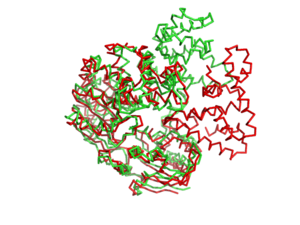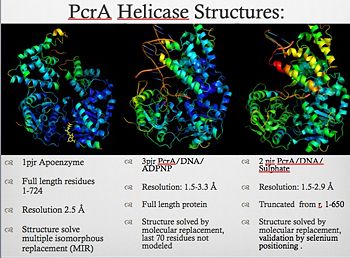Molecular Playground/PcrA Helicase
From Proteopedia
(Difference between revisions)
| Line 18: | Line 18: | ||
==PcrA Helicase Mechanism : The Mexican Wave== | ==PcrA Helicase Mechanism : The Mexican Wave== | ||
| - | <Structure load='1pjr' size='350' frame='true' align='right' scene='User:Luis_E_Ramirez-Tapia/Sandbox_2/3pjrinitial/1' caption='PcrA Helicase Structure [[1pjr]]' /> | ||
Professor Dale B. Wigley' group in 1996-1999 was able to crystalize the intermediate states from PcrA, giving solution to the controversy of what kind of mechanism this helicase has. [http://www.ncbi.nlm.nih.gov/pubmed/10199404ordinalpos=39&itool=EntrezSystem2.PEntrez.Pubmed.Pubmed_ResultsPanel.Pubmed_DefaultReportPanel.Pubmed_RVDocSum] | Professor Dale B. Wigley' group in 1996-1999 was able to crystalize the intermediate states from PcrA, giving solution to the controversy of what kind of mechanism this helicase has. [http://www.ncbi.nlm.nih.gov/pubmed/10199404ordinalpos=39&itool=EntrezSystem2.PEntrez.Pubmed.Pubmed_ResultsPanel.Pubmed_DefaultReportPanel.Pubmed_RVDocSum] | ||
| - | Two crystal form of the enzyme, one couple with a 10 mer DNA and a non hydrolizable form of ATP (ATPnP)([[3pjr]]), <scene name='User:Luis_E_Ramirez-Tapia/Sandbox_2/3pjrinitial/1'>(Enzyme Subtrate Structure) </scene>and another a truncated form embebed in sulfate ([[2pjr]])<scene name='User:Luis_E_Ramirez-Tapia/Sandbox_2/2pjrinitial/1'>(Enzyme Product Structure)</scene>, give a light in a model for how ATP hydrolysis results in motor movement along ssDNA. In the figure below step 1 (top) is the ATP free (product) ssDNA conformation. The DNA bases are labelled arbitrarily. On binding ATP, F626 creates a new binding pocket for base 6. Likewise, F64 destroys an acceptor pocket for base 2, forcing it to move to the position occupied by base 1. After ATP hydrolysis, the grip on base 6 is released. When the Y257 pocket is re-opened due to movement of F64, bases 3-6 can now flip through the acceptor pockets to their new positions. This model predicts that each ATP hydrolysis event will advance PcrA one base along ssDNA.[http://www.icnet.uk/labs/wigley/projects/helicase/35.html] | + | Two crystal form of the enzyme, one couple with a 10 mer DNA and a non hydrolizable form of ATP (ATPnP)([[3pjr]]), <scene name='User:Luis_E_Ramirez-Tapia/Sandbox_2/3pjrinitial/1'>(Enzyme Subtrate Structure)</scene> and another a truncated form embebed in sulfate ([[2pjr]])<scene name='User:Luis_E_Ramirez-Tapia/Sandbox_2/2pjrinitial/1'>(Enzyme Product Structure)</scene>, give a light in a model for how ATP hydrolysis results in motor movement along ssDNA. In the figure below step 1 (top) is the ATP free (product) ssDNA conformation. The DNA bases are labelled arbitrarily. On binding ATP, F626 creates a new binding pocket for base 6. Likewise, F64 destroys an acceptor pocket for base 2, forcing it to move to the position occupied by base 1. After ATP hydrolysis, the grip on base 6 is released. When the Y257 pocket is re-opened due to movement of F64, bases 3-6 can now flip through the acceptor pockets to their new positions. This model predicts that each ATP hydrolysis event will advance PcrA one base along ssDNA.[http://www.icnet.uk/labs/wigley/projects/helicase/35.html] |
[[Image:Mexicanwave.jpg|thumb|270px|left|Inchworm or Mexicanwave model]] '''The link below shows a movie with the principal characteristics of this protein as long with the inchworm model'''. [http://www.youtube.com/watch?v=veY0LlL7Dt0 Pcr4 Helicase and Mexican Wave] | [[Image:Mexicanwave.jpg|thumb|270px|left|Inchworm or Mexicanwave model]] '''The link below shows a movie with the principal characteristics of this protein as long with the inchworm model'''. [http://www.youtube.com/watch?v=veY0LlL7Dt0 Pcr4 Helicase and Mexican Wave] | ||
{{clear}} | {{clear}} | ||
Revision as of 09:37, 10 April 2013
| |||||||||||
Proteopedia Page Contributors and Editors (what is this?)
David Canner, Michal Harel, Alexander Berchansky, Luis E Ramirez-Tapia






